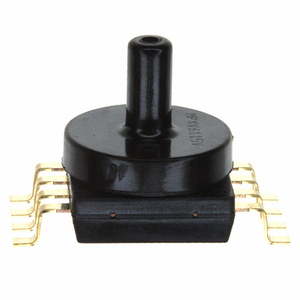
Please note: COVID-19 has made many parts less available. Most suppliers are indicating that new sensors will be available soon. The new good news is I was able to use the OpenAI artificial intelligence engine online to identify substitute parts that were available. This post has been updated to include more potential part numbers.
The sensors are the most expensive part. The price varies between suppliers. They regularly go on sale. There are odd lots available, even on eBay. Sometimes they are much cheaper to buy on a piece of tape roll than on a rail (these are different automated assembly techniques) or vice versa. Some substitutes work just as well. Make 2 or three boards or go together with friends – the more you can buy, the cheaper they get.
Start with a search on ‘MPXV6115VC6U’. This is the standard sensor in the bill of materials. Search on some of the other part numbers, too.
Sometimes these parts are available, but ensure that you are ordering a sensor with a top port – MPXV5050VC6T1, MPXV4115VC6U, MPXV6115VC7T.
Shop around. Below are links to a few examples. The board can be set to run on either 5v or 3.3v sensors.
Here’s a search engine that can sometimes find things: http://www.findchips.com/
Another search engine that can be very useful is https://octopart.com/search?q=MPXV6115VC6U.
Another search engine: https://www.eciaauthorized.com/en/search/MPXV6115VC6U
Another search engine: https://www.onlinecomponents.com/
Contact us if you find something new, and we’ll check it out. Here are the basics.
You need a vacuum sensor for each cylinder. It should measure vacuum from approximately negative 7 to 10 pounds per square inch up to zero vacuum. Or, if measured in kPa, negative 60 to 115 kPa up to at least zero vacuum. The part shown in the picture measures -115 kPa to 0. Most bikes will idle and rev in the 7 to 10 lbs per square inch range of vacuum.
It should be in a standard SOM package, with a port, either smooth or barbed. See the picture with a smooth port and 8 ‘legs’.
It should run on either 5 volts or 3.3 volts. These are standard. The board can be built for either. Sometimes a range around the voltage value is advertised in the sensor specs. For example, a spec might say input voltage 2.2 to 4.6 volts instead of just saying 3.3v.
It should output analog voltage, zero through up to approximately 5 volts.
If you find something, compare the spec sheet to the spec sheets of the options below, especially the Digikey. Use the standard sensor from Digikey unless you find something at a great price.
Last updated 4/11/2025